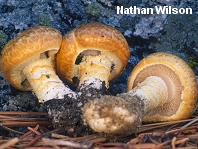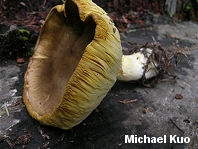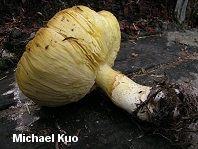| Major Groups > Gilled Mushrooms > Pale-Spored > Tricholoma / Floccularia > Floccularia albolanaripes |

|
Floccularia albolanaripes [ Basidiomycetes > Agaricales > Tricholomataceae > Floccularia . . . ] by Michael Kuo Formerly known as Armillaria albolanaripes, this western species is quite attractive when young, though it tends to become a bit drab in maturity. It is found under conifers in the Rocky Mountains, especially after fall rains--and under hardwoods (or occasionally conifers) on the West Coast, in fall and winter. The defining features of Floccularia albolanaripes include its medium size and fairly stocky stature; its brownish mature cap, which is adorned with pressed-down fibers; its stem, which is shaggy except near the apex; its white spore print; and, under the microscope, its amyloid, smooth spores. Floccularia straminea is similar, but features brighter yellow colors and fully developed scales, rather than pressed-down fibers. Readers who are fortunate enough to own Alexander Smith's 1949 Mushrooms in Their Natural Habitat (now out of print), as well as the accompanying View-Master reels that illustrate the book, will find Floccularia albolanaripes on Reel 15, in a stunning 3-D photo by William B. Gruber. More than half a century later, virtual reality technology has yet to approach the amazing, feel-like-you're-there sensation of the View-Master, in my humble opinion. An all-white, "albino" form is recorded by Mitchel & Smith (1976), who call it Armillaria albolanaripes f. alba. It has not yet been officially transferred to Floccularia, to my knowledge. Since there is also an albino form of Floccularia straminea, the only feature separating these white forms is the scaliness of the cap (truly scaly in Floccularia straminea; appressed-fibrillose in Floccularia albolanaripes). Description: Ecology: Probably mycorrhizal; usually associated with conifers in the Rocky Mountains, but associated with hardwoods (especially oaks and alders) or conifers on the West Coast; growing alone or scattered; western in distribution; summer and fall in the Rockies; fall and winter on the West Coast. Cap: 4-12 cm; convex when young, becoming planoconvex or flat; slightly sticky at first but soon dry; adorned with pressed-down fibers (especially over the center); in maturity sometimes with a few small scales; often bright yellow when young but usually soon yellow-brown or brown, at least over the center; the margin usually becoming yellow with age. Gills: Attached to the stem by a notch, or nearly free from the stem; close; whitish or yellowish. Stem: 2-8 cm long; up to 2.5 cm thick; more or less equal; whitish and smooth near the apex; sheathed below with shaggy zones of soft scales that are whitish at first but may develop yellowish or brownish tips; sometimes with a poorly defined ring ("the uppermost zone purely by virtue of its position is considered the annulus," says Smith). Flesh: White or a little yellowish; not changing on exposure. Taste: Not distinctive; odor not distinctive. Spore Print: White. Microscopic Features: Spores 5-8 x 4-5 µ; smooth; elliptical; amyloid. REFERENCES: (Atkinson, 1908) Redhead, 1987. (Smith, 1949; Mitchel & Smith, 1976; Smith, Smith & Weber, 1979; Arora, 1986; States, 1990; Lincoff, 1992.) This site contains no information about the edibility or toxicity of mushrooms. |
© MushroomExpert.Com |
|
Cite this page as: Kuo, M. (2006, October). Floccularia albolanaripes. Retrieved from the MushroomExpert.Com Web site: http://www.mushroomexpert.com/floccularia_albolanaripes.html |


